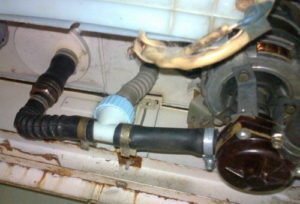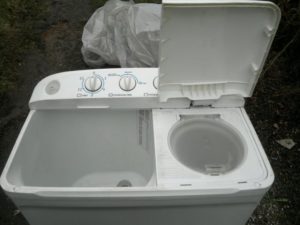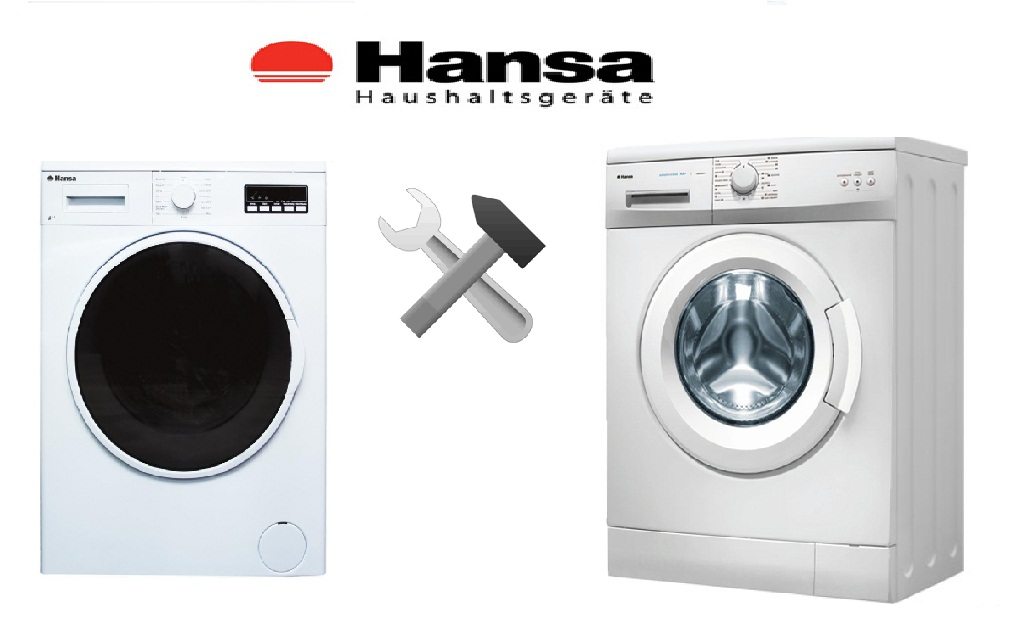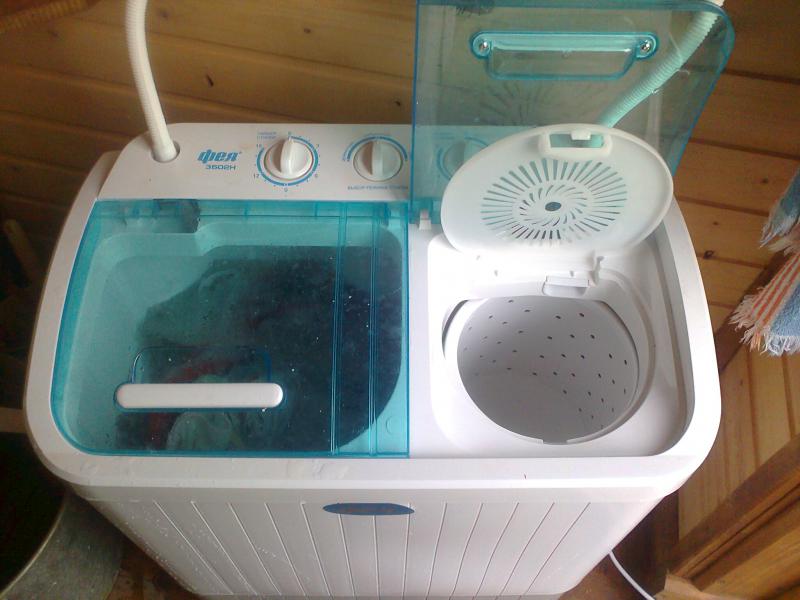Repair of faults in semi-automatic washing machines
 Semi-automatic washing machines have not yet been replaced by automatic machines and are often found in dachas and in houses without running water. They, like any complex mechanism, break down and may require repairs. Having simple skills in working with equipment and the ability to read electrical diagrams, you can repair a semi-automatic machine with your own hands without taking it to a repairman for repairs. We will help you understand common problems and how to resolve them.
Semi-automatic washing machines have not yet been replaced by automatic machines and are often found in dachas and in houses without running water. They, like any complex mechanism, break down and may require repairs. Having simple skills in working with equipment and the ability to read electrical diagrams, you can repair a semi-automatic machine with your own hands without taking it to a repairman for repairs. We will help you understand common problems and how to resolve them.
Frequent malfunctions and their causes
Semi-automatic washing machines with or without spinning, they have a long list of breakdowns. All of them, in one way or another, are associated with either washing or spinning, that is, the machine either does not wash or does it poorly, or does not spin. We list the malfunctions of such washing machines:
- The machine does not start to wash, the engine is silent. When the machine does not respond when turned on, the cause may be either a simple malfunction of the plug or socket, or a breakdown of the engine or electrics.
- The machine hums, but the activator or drum does not rotate. The reason for this malfunction is the absence of a drive, that is, the drive belt has fallen off.
- If water is leaking from under the washing machine, then the cause must be sought in a broken pump, pipe or machine body.
- If the machine does not pump out water or does it poorly, the reason lies in a clogged hose or pump.
- Water leakage during spinning indicates a breakdown of the drain pump, centrifuge tank, loose connections of the drain system components, damage to the drain valve or rubber seals.
- The centrifuge does not spin and the engine does not work, which means there is a breakdown in the engine or electrics.If the motor hums but does not rotate, then the centrifuge tank may have been overloaded with water or laundry.
Repairing automatic washing machines will require not only certain skills, but also the availability of free time and tools, such as open-end wrenches, pliers and a multimeter, as well as spare parts to replace faulty elements.
There can be problems with spare parts, so repairing semi-automatic washing machines is often not practical.
Problems with drainage and water leakage
To fix problems with semi-automatic washing machines related to water leaks and drainage with your own hands, you can use the following instructions.
- We turn off the semi-automatic machine from the network and check for blockages. If necessary, clean the filter and drain hose. Along the way, check to see if the drain hose is kinked or if there are any holes in it.
- Next, using a screwdriver, open the body of the machine and find the drain pump.
For your information! Depending on the model of the machine, there may be two of them, one for the centrifuge drain, the other for the washing tank. If there is only one pump, then the washing tank is drained by gravity.
- We disconnect the pump and open it to clean the impeller from debris. We also check its functionality with a multimeter or ohmmeter. If the pump winding is burned out, it will have to be replaced with a new one.
- In cases of water leaks, you should also check parts such as gaskets, diaphragm and membrane. They can easily be replaced with similar ones.
- We check the tightness of the connections of the drain system, between the pump and the pipes, as well as the water drain valve.
- If you have a centrifuge, check the tank for damage and cracks. If there are any, then we seal them with sealant or cold welding, after first removing the tank from the semi-automatic machine.
Repair of moving parts
In this paragraph we will talk about malfunctions associated with the engine and drive parts that rotate the drum or activator. If the centrifuge does not rotate during spinning, you must first ensure that the tank is not overloaded with laundry. To do this, take out some of the things and try turning on the spin cycle again. If nothing happens, then the machine will have to be disassembled.
 The main problem in engine operation is the wear of the brushes; replacing them with your own hands can be difficult for someone who is going to do it for the first time. To change them, remove the engine of the semi-automatic machine. Then disconnect the wires from the brushes and remove the brushes. Take the new brushes and insert them the way the old ones were, that is, in the same direction of the ground corner. Then connect the wires and secure the motor in the car.
The main problem in engine operation is the wear of the brushes; replacing them with your own hands can be difficult for someone who is going to do it for the first time. To change them, remove the engine of the semi-automatic machine. Then disconnect the wires from the brushes and remove the brushes. Take the new brushes and insert them the way the old ones were, that is, in the same direction of the ground corner. Then connect the wires and secure the motor in the car.
If the centrifuge motor fails, it will have to be replaced. Let's look at the replacement using the Siberia washing machine as an example.
- Using a 10mm wrench, unscrew the 6 bolts holding the top cover of the semi-automatic machine.
- Unscrew the tank nut. It is better to do this together, one should hold the centrifuge tank, and the second should unscrew the nut.
- We also remove the tank from the shaft together using a hammer. One holds, the other hits.
Note! You need to hit it with a hammer carefully, otherwise such repairs may result in new problems.
- If it’s going hard and you don’t even need to hammer the tank with a hammer, spray WD-40 liquid on the shaft and try again.
- We move the tank to the side, and then take out the mounting pin, which is inserted into the engine shaft.
- The next step is to lift the body of the machine and place it upside down.
- Carefully remove the motor from the washing machine body.
Now we just have to decide what to do with the old engine. You can try to restore it by giving it to a specialist to rewind (rewinding it yourself is not an option), or you can find and purchase a working engine. Both options will be very expensive, it’s easier to buy a new semi-automatic washing machine, but if repairs are a matter of principle, then it’s up to you to decide.
Electrics
If the engine does not work correctly or does not work at all, it is not necessarily the problem. It is quite possible that the main reason lies in the electrics. To repair semi-automatic washing machines of this kind, you will have to get the electrical circuit for your “home assistant” model.
For your information! Absolutely all semi-automatic washing machines produced during the Soviet period were equipped with electrical circuits to simplify repairs. Modern semi-automatic machines come with only an instruction manual, but this does not mean that the diagram cannot be found on the Internet.
 Before you start repairing the electrics of semi-automatic washing machines, you need to understand what exactly went wrong. Let's look at the symptoms. The main symptom is that the motor stops functioning during spinning, but works normally during washing. What possible breakdowns may occur?
Before you start repairing the electrics of semi-automatic washing machines, you need to understand what exactly went wrong. Let's look at the symptoms. The main symptom is that the motor stops functioning during spinning, but works normally during washing. What possible breakdowns may occur?
- One of the wires in the electrical circuit of the machine is broken or frayed. Old semi-automatic washing machines often have such problems.
- The microswitch has failed, the thermal relay or time relay has broken.
- The start relay or start capacitor has burnt out.
- The transformer burned out.
How to determine what exactly is broken, how to check all these elements? Semi-automatic washing machines do not have a self-diagnosis system, so you will have to determine the cause yourself. You need to take an electrical diagram, look at the normal resistance of all the above parts, then arm yourself with a multimeter and check them all one by one, each module and each wiring. With some skill, this work will take 30-40 minutes.
If the fault is not found, repeat the check from the beginning, noting the modules that have already been checked; perhaps something was missed the first time. If a burnt element of the electrical circuit is detected, it must be replaced.
In conclusion, let us once again note a very important point. Before you start repairing a semi-automatic washing machine, evaluate its economic feasibility. Perhaps “the game is not worth the candle.” Good luck!
Interesting:
25 reader comments
Add a comment Cancel reply
Categories
Washing machine repair


For buyers

For users

Dishwasher

















The engine rotates and the activator stops, but the belt is tensioned. What to do?
The same problem... but the activator does not stand, but rotates slowly and creakingly. I think foreign debris got under the activator. How to remove the activator and check?
Most likely the activator drive (gearbox) has failed.
But if it works in gentle mode, but when switching to normal mode, the timer ticks, but the machine does not work, what is the reason?
How to change the centrifuge seal on a Saturn washing machine?
My centrifuge does not spin, but it hums.What could this be, please tell me?
The drain doesn't work! What to do?
The machine turns in one direction and hums in the other. What could this be, someone tell me?
Engine replacement.
The bottom of my machine has floated up (..this disk with pimples... The computer is working properly.. but the drum is now standing still.. What should I do?
Both reels spin at the same time
Water from my washing machine goes into the centrifuge, how do I replace the valve?
The valve needs to be cleaned, not replaced.
The belt is loose, how to tighten it?
The centrifuge does not squeeze out
You need to remove the drum in the Saturn machine. I don’t understand how. There are 2 tanks. One for washing, the other for spinning. I need to remove the one that washes.
New semi-automatic machine. It washes well, the activator turns, but the sound is unclear. It feels like it turns normally in one direction, but with some effort in the other. The laundry bounces well. I took out the laundry and with just water the sound was normal. I don't overload the machine. What could be the reason?
Possibly a weak belt.
Water from the machine goes into the centrifuge, how to clean the valve?
I changed the hose from the bottom of the machine and fastened it with wire. And this place is leaking water, what should I do? How to attach a hose so it doesn't drip?
The wash timer does not work on the Slavda semi-automatic machine
When turned on, the activator rotates in one direction, and when the direction of rotation of the activator should change, everything stops. If you slightly push the activator, it begins to rotate until the next switch in the same direction. Can you tell me what could be the reason?
Give me the electrical diagram of the Saturn semi-automatic machine
Semi-automatic machine Snow White. It tears clothes when washing, gives an electric shock during operation and when the cord is plugged in and the washing machine is turned off.
Hello! Machine Artel. The motor is running, the repairs are tight, but the activator cannot start, it barely turns. Please tell me what to do?